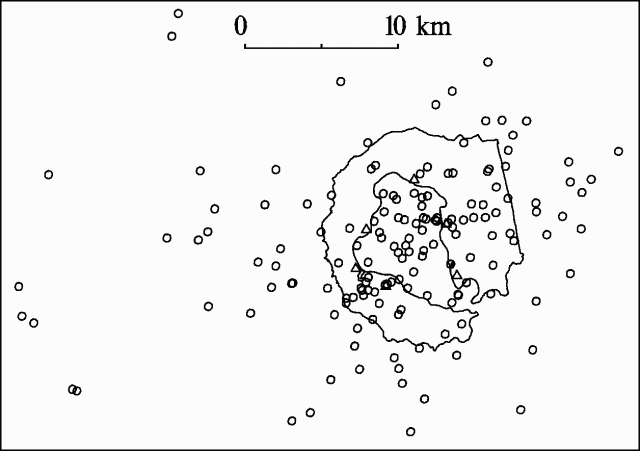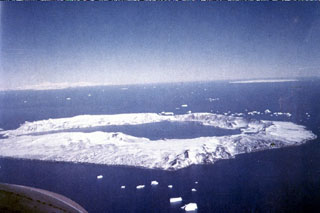Report on Deception Island (Antarctica) — March 1990
Bulletin of the Global Volcanism Network, vol. 15, no. 3 (March 1990)
Managing Editor: Lindsay McClelland.
Deception Island (Antarctica) More than 1,000 seismic events recorded in one month
Please cite this report as:
Global Volcanism Program, 1990. Report on Deception Island (Antarctica) (McClelland, L., ed.). Bulletin of the Global Volcanism Network, 15:3. Smithsonian Institution. https://doi.org/10.5479/si.GVP.BGVN199003-390030
Deception Island
Antarctica
62.9567°S, 60.6367°W; summit elev. 602 m
All times are local (unless otherwise noted)
"Spanish scientists visited Deception Island in December 1989 and January-February 1990. A geophysical station is located on the island and the Spanish oceanographic vessel Las Palmas operated in the area. Geological, tectonic, and geophysical features on and near the island were investigated. A regional, higher precision GPS geodetic network spans the Deception section of the Bransfield Rift.
"During the 1989-90 field season, an array of six digital seismic stations was installed on Deception Island. More than 1,000 events (0.5-2.1 mb) were digitally recorded. The major shocks were located in de Neptune Bowels (S of the island). The distribution of events shows a good correlation with tectonic features on and near the island (figure 2). A low seismic velocity, high-attenuation body was inferred under the NE sector of the island. A negative magnetic anomaly (-4,900 nT) is located in the same area.
 |
Figure 2. Distribution of seismic events (circles) recorded by the Spanish Antarctic Program seismic array (triangles) on Deception Island, 20 January-20 February 1990. |
"Chemical compositions of samples from fumaroles and thermal springs suggest a thermal anomaly related to an underlying magma body. Gas geothermometry shows a formation temperature >250°C, with an outflow temperature of about 100°C. The phreatomagmatic character of the recent episodes is hypothesized as the result of a magma intrusion into shallow and confined water-saturated layers.
"A permanent seismic station monitoring the seismic activity in the area has been established at Spain's Juan Carlos I facility (35 km from Deception)."
Geological Summary. Ring-shaped Deception Island, at the SW end of the South Shetland Islands, NE of Graham Land Peninsula, was constructed along the axis of the Bransfield Rift spreading center. A narrow passageway named Neptunes Bellows provides an entrance to a natural harbor within the 8.5 x 10 km caldera that was utilized as an Antarctic whaling station. Numerous vents along ring fractures circling the low 14-km-wide island have been reported active for more than 200 years. Maars line the shores of 190-m-deep Port Foster caldera bay. Among the largest of these maars is 1-km-wide Whalers Bay, at the entrance to the harbor. Eruptions during the past 8,700 years have been dated from ash layers in lake sediments on the Antarctic Peninsula and neighboring islands.
Information Contacts: R. Ortiz, Museo Nacional de Ciencias Naturales, Spain; Rafael Soto, Real Instituto y Observatorio de la Armada, Spain.

